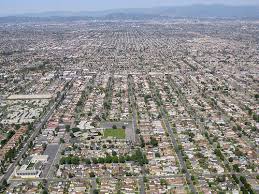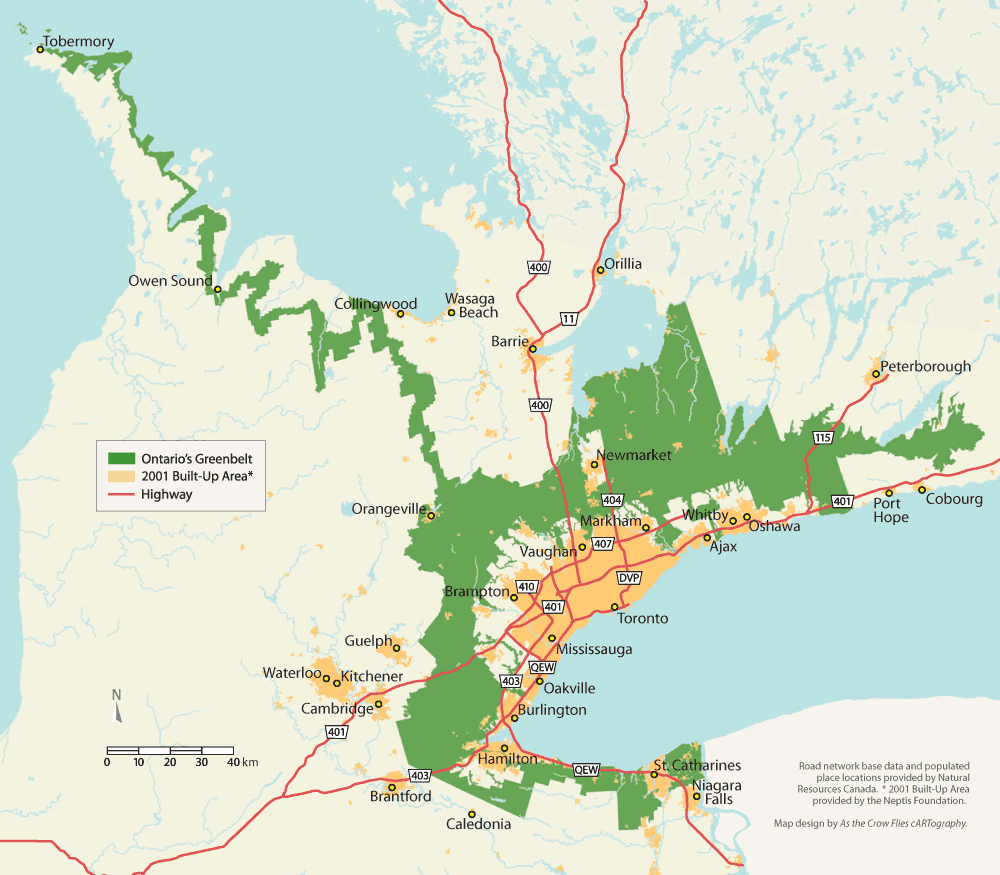 By Ray Rivers
By Ray Rivers
March 27, 2015
BURLINGTON, ON
Urban sprawl – it even sounds like a dirty word. Sprawl has gobbled up more potential farm and natural lands than any other form of development.

Gas and land were cheap and it was the way people wanted top live. It will take several decades to unwind all this urban sprawl – perhaps Burlington could become a leader in the change.
Because of the distances involved in servicing subdivisions and the inherent low population densities, sprawl is also the most costly form of development. And sprawl is dependent on the automobile as the primary (or sole) means of transportation, resulting in gridlock and the consequent lengthy commute times.
These downsides were recognized soon after this ‘California’ lifestyle became the dominant form of development in the fifties and sixties. But once adopted, going back was a tough call. There is so much more profit for developers in buying up cheap farm land and converting it to houses, than in expanding housing in existing built-up areas.
Back in the day, before immigration swelled our urban envelope, most of us hardly thought twice about the suite of problems associated with these ‘burbs’ popping out all around us. But Ontario’s Premier Bill Davis did. He, no doubt, had observed what had been happening to the US rust-belt cities, as suburban development swallowed up prime farm land and hollowed out the inner city core in the process, until nobody wanted to live downtown anymore.
So as early as the 70’s the Davis government sought to keep Ontario’s canvas painted more green than black. Putting an end to paving paradise and putting up more parking lots, as the folk singer Joni Mitchell had warned, was a timely ambition. So he undertook to create Ontario’s first greenbelt, setting out the Niagara Escarpment Commission to ensure protection from development.

Bill Davis made decisions while he was Premier that made possible the protection of the environment that is being done now.
And Davis didn’t stop there, he established the most advanced municipal planning system in North America. To help implement the system, he created new higher-tier regional governments to implement broad scale regional plans, which would permit stable and progressive development over a generation, while protecting farm and natural lands.
But it didn’t really work. The development industry is a powerful lobby and whether through their persistence at council meetings, campaign contributions for municipal candidates or sound arguments, they have been able to sway many development decisions in their favour – decisions that always involve more sprawl development.
And regional plans themselves became a catalyst for accelerated development. Once a land parcel was designated, developers pushed for early approvals in order to get their money out of the projects. And if that didn’t work there was always an appeal to the Ontario Municipal Board (OMB).
The OMB is a quasi-judicial institution which is an anomaly in Canada. Composed of political appointees, this unaccountable body acts as both judge and jury, and frequently overrides the authority of our elected representatives, making a mockery of municipal democracy. The Canadian Senate comes to mind, except that the OMB has real power.
In the end Ontario, with its fancy planning system ended up with about as much urban sprawl as did the bordering US jurisdictions with their more basic laissez-faire systems of municipal planning. It turns out politics, not planning, was at the heart of the issue.

The Greenbelt – in place as a boundary to protect natural space
My Conservative friends would prefer to remember Dalton McGuinty for the unfortunate billion dollar gas plant fiasco of a few years ago. But history will record the creation of Ontario’s current Greenbelt as one of his greatest achievements. Following the visionary lead of Mr. Davis, three decades before him, this is the single most important instrument the province now has to hold back the forces of urban sprawl.
Of course, even this initiative could not quash those development plans already underway, such as the ones which have transformed Milton into the textbook case of what not to do. The recent orgy of development there has transformed the once quaint town such that it is now unrecognizable. And as anyone driving on the 401 will attest, this development has also made the roadways largely impassable.
Last week I attended a meeting in Milton, sponsored by the Friends of the Greenbelt. The topic was preserving prime agricultural land and the meeting was well attended by urban planners, farmers and other business people, keen on making their thoughts known.. Listed below are links to other sessions in which the public can have their say on the Greenbelt and its future in Ontario.
Whether you are a farmer concerned about city-folk moving next door and then complaining about your hog operation; a nature-lover craving more opportunity for environmental diversity; or a developer wanting to build more houses on a farm you have just purchased, this is your chance to have your say.
Of course I drove to the meeting, but I did take the backroads to avoid sitting on that parking lot we call the 401. And there you have it – this time using the automobile to fight against urban sprawl.
 Ray Rivers writes weekly on both federal and provincial politics, applying his more than 25 years as a federal bureaucrat to his thinking. Rivers was a candidate for provincial office in Burlington where he ran as a Liberal against Cam Jackson in 1995, the year Mike Harris and the Common Sense Revolution swept the province.
Ray Rivers writes weekly on both federal and provincial politics, applying his more than 25 years as a federal bureaucrat to his thinking. Rivers was a candidate for provincial office in Burlington where he ran as a Liberal against Cam Jackson in 1995, the year Mike Harris and the Common Sense Revolution swept the province.
Background links:
State of the Lakes Ecosystem Conference



















Hi guys, lets’s make the world a better place. But you have to knock it off with these fairy tales. Once upon a time doesn’t cut it. Here’s some inconvenient facts. Developers would make much more money building high rise buildings that take up very little land and would allow folks to live like pigeons in the air. They would virtually have little land cost. 200 feet by 200 feet could get you 100 units of 700 sq. ft. sardine cans, Steve seems to adore. Keep the cost under $450,000 and you pay no HST. So you would have us believe the big developers don’t want this. ADI Developments just side stepped council and is going straight to the OMB to have get permission to build one of these save the environment buildings. You talk quite a bit but say very little. Are these behemoth buildings the future of Ontario in your eyes. Where would children play in the hallways? As far as land ownership over 95% of land in Ontario is owned, or its use controlled by Big Brother.So stop with the exaggerated info. Let me let you in on a little known secret that only developers seem to know. Development charges are paid by the poor home purchasers as they are passed on by the developers as well as the HST. and about $220,000 in various fees and taxes. That the government pretends to blame the developers for. Only a hand full of people think that home buyers are not already paying too much. Bob why would you tax people on their profit on their homes. People in New York make Billions selling their apartment units every day.Get serious!
Another way to reduce urban sprawl is to pass a one child only law and make private property ownership illegal. This way the government can issue apartments of equal size (700sq ft) to everyone. Only strict central planning will be effective.
Thanks for your comment Bob. I’d push for full cost development charges as an adjunct policy to help control urban sprawl. The province is already moving in that direction by adding transportation to the list of services that developers will be required to pay for as part of their responsibilities in building communities.
Governments could easily reduce urban sprawl with 2 simple taxation steps:
•tax gas & diesel far above their criminally low current levels, and
•Capital Gains taxes, that would also be applicable to the personal residence, could be increased to absorb the lion’s share of net real property dispositions.
It was once a maxim in the First Nation’s community that nobody owned the land; it was meant to be shared. If we paid better head to that, perhaps we would all be better stewards.